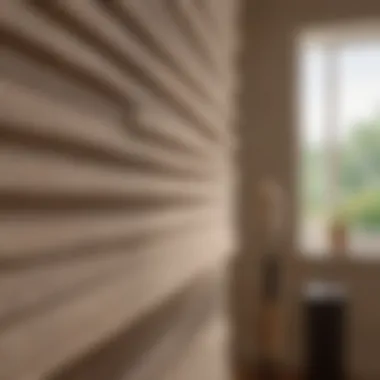Expert Tips on Cleaning Your Blinds Effectively


Intro
Cleaning blinds is more than just an aesthetic choice; it plays a significant role in maintaining the overall ambiance and hygiene of your living space. This meticulous task often gets overlooked in the hustle of daily life. Yet, those various window treatments, whether they are wooden, vinyl, or fabric, require attention to preserve their functional and decorative qualities. This article serves as a comprehensive guide designed to assist you in understanding how to effectively clean your blinds based on the material used, while also highlighting the tools and techniques necessary for the task.
Exquisite Architectural Designs
Blinds add a subtle elegance to any architectural design, whether in modern residences, historical homes, or cozy apartments. They not only enhance privacy but also contribute to the visual character of a space.
Unique Home Features
Every architectural design is unique and often integrates blinds that complement its style. From sleek Venetian blinds in loft apartments to intricate wooden ones in a Victorian house, each type serves a particular purpose in enhancing the interior. Understanding your home's design helps in choosing the right cleaning method, ensuring longevity and maintaining charm.
Historical Significance
Historically, window treatments, including blinds, have undergone transformations influenced by cultural shifts and technological advancements. Knowing this context might inspire more care in maintaining your blinds. It's not just about cleaning but understanding their story and preserving their heritage in your home.
Interior Decorating Tips
In the realm of interior decorating, blinds serve as a foundation that can either make or break a room's design. Properly maintained blinds can enhance the aesthetics while also ensuring functionality.
Color Schemes and Trends
The choice of blinds should align with the room's color scheme. Neutral tones offer versatility, but bold colors can make a statement. Regular cleaning helps maintain those hues, adding to the overall visual appeal of the space.
Space Optimization Techniques
The right kind of blinds can optimize natural light, enhancing the perception of space within a room. Cleaning methods vary based on the type of blinds, but knowing how to efficiently clean them allows you to unlock their full potential, ensuring they remain both stylish and functional.
"A well-maintained set of blinds not only transforms the room's look but also influences its feel."
In summary, cleaning your blinds is an essential part of home maintenance that no homeowner should overlook. Regular attention will not only enhance the overall beauty of your space but also prolong the life of these vital window coverings.
Understanding Different Types of Blinds
Cleaning methods for blinds can depend heavily on the type of blind one possesses. An understanding of the various types—each with unique materials and designs—helps in applying the right cleaning technique. Differentiating among the types also ensures that cleaning solutions used do not damage the surface or mechanism of the blinds. Regular maintenance improves not only the aesthetic appeal but also the functional capacity of window treatments. The sections below explain various types of blinds and their cleaning considerations.
Vertical Blinds
Vertical blinds are composed of long, vertical slats that can be turned to control light entry. These blinds are commonly made of fabric or vinyl. Dust can accumulate on the surfaces quickly due to the vertical arrangement. Cleaning is generally simple; a gentle wipe with a microfiber cloth or mild cleaning solution suffices. Fabric vertical blinds may require a more extensive cleaning process, including vacuuming or steam cleaning, to remove stubborn stains and allergens.
Horizontal Blinds
Horizontal blinds, often made of wood, faux wood, or aluminum, consist of horizontal slats. Their design allows for effective light control. However, they can attract dust and grime more than other types. Regular dusting is essential to keep them clean and to maintain their finish. For wooden blinds, it's important to use a mild solution because harsh chemicals can lead to warping or cracking. Vacuuming with a brush attachment can help remove dirt build-up in the slats.
Roller Blinds
Roller blinds are typically made from fabric that rolls up and down. Their simplicity makes them a popular choice. Cleaning fabric roller blinds may involve spot cleaning or, in some cases, whole fabric removal for laundering. For typical dust and light stains, a duster or dry cloth is adequate. However, periodic deep cleaning will maintain their color and quality over time.
Roman Blinds
Roman blinds are made of fabric that folds up in pleats when raised. Their soft, elegant look adds a touch of style to any room. Cleaning these blinds involves careful handling. Spot cleaning is preferable, but in the case of deep stains, it’s often best to remove them and have them cleaned professionally. Regular vacuuming can prevent dirt accumulation, especially in the folds.
Cellular Shades
Cellular shades, known for their energy efficiency, feature a unique honeycomb design. They trap air, providing insulation and light control. Dust tends to settle into their cells, making regular cleaning a necessity. A gentle vacuuming can help. For deeper cleaning, mild solutions and soft brushes should be utilized, making sure no water seeps into the fabric. This prevents damage and maintains their performance.
Tools Required for Cleaning
Cleaning your blinds effectively hinges on using the right tools. This section outlines essential items needed to achieve optimal cleanliness and maintain the aesthetics of your window treatments. Proper tools not only simplify the cleaning process but also help avoid damage to blinds made from various materials.


Microfiber Cloths
Microfiber cloths are an excellent choice for cleaning blinds. They are designed to trap dust and dirt particles effectively. Unlike traditional cloths, microfiber is soft and non-abrasive, which minimizes the risk of scratching delicate surfaces. Using these cloths helps gather dust without merely pushing it around.
In addition, microfiber can be washed and reused, making it an economical and environmentally friendly option. Consider using specific colored cloths for different areas of your home to avoid cross-contamination and ensure hygiene.
Vacuum Cleaner with Brush Attachment
A vacuum cleaner equipped with a brush attachment can save time and effort. This tool allows you to remove dust build-up in a more comprehensive manner. The brush helps agitate the dust, loosening it from the blinds while the suction captures it.
It’s advisable to use the vacuum cleaner regularly to prevent dust accumulation. Remember to adjust the suction power accordingly to cater to various blind materials. If blinds are particularly fragile, a gentler mode will suffice.
Lambswool Duster
The lambswool duster is another valuable tool when cleaning blinds. Made from soft wool, it is ideal for reaching slats and corners that might be challenging to clean with a cloth. The natural fibers pick up dust effectively without the need for additional cleaning products.
When using a lambswool duster, ensure that the fibers are clean. A dirty duster can transfer more dirt back onto your blinds. Regular cleaning of the duster itself will extend its effectiveness and lifespan.
Mild Cleaning Solutions
Mild cleaning solutions are essential to avoid damaging the material of the blinds. Harsh chemicals can lead to discoloration or degradation. It is wise to select non-toxic, biodegradable products that are safe for both the environment and your household.
Common mild solutions include a mixture of water and vinegar or a few drops of dish soap. Before applying any solution, it is crucial to test the cleaner on a small, inconspicuous area to ensure compatibility. This precaution helps prevent unwanted reactions that might affect the appearance of your blinds.
Water and Bucket
Water is a fundamental component in the cleaning process. A simple bucket filled with warm water can assist in rinsing off dirt or mild cleaning solutions.
Using lukewarm water can be effective for washing fabric-based blinds. It helps in dissolving the grime without risking temperature shock. While cleaning, be cautious not to over-saturate the blinds, as excess water can lead to warping or mold growth.
Regularly gathering these tools makes the entire process more efficient. Keeping your blinds clean contributes to the overall appearance of your home.
In summary, equipping yourself with the right tools can significantly enhance your cleaning regimen. Each item serves a specific purpose to ensure that your blinds remain clean and aesthetically pleasing.
Preparing to Clean
Preparing to clean your blinds is a crucial step that should not be underestimated. This phase allows you to gather the right mindset and tools for effective cleaning, ultimately reducing unnecessary stress. Without preparation, you may face inefficiencies or even cause damage to your blinds.
Importance of Preparation
Taking time to assess the situation and understand the condition of your blinds is fundamental. This helps in determining the most suitable cleaning method. Furthermore, by preparing effectively, you can streamline the cleaning process, maintaining focus and ensuring thoroughness.
Assessing the Condition of Blinds
Before starting the cleaning process, it's essential to evaluate the condition of your blinds. Look for signs of wear or damage. Inspect any stains, dust accumulation, or mold growth. This evaluation can guide your cleaning method—certain materials may require gentler products and techniques than others.
For example, wooden blinds can warp if too wet, while vinyl ones may withstand more moisture. Understanding these nuances will help you choose effective cleaning solutions that will not harm the blinds.
Choosing the Right Time
Timing can be a significant factor in the cleaning process. It is advisable to clean blinds when you have ample time and can avoid interruptions. Cleaning in the middle of a busy schedule can lead to rushed work, increasing the risk of mistakes or incomplete tasks.
Consider cleaning your blinds on a day when the weather is conducive. For instance, choose a dry day when you can easily allow natural ventilation while washing. This can help in drying any moisture that may accumulate during cleaning.
Gathering Necessary Supplies
Gathering the right tools and supplies is a critical step. Having everything needed at hand will prevent unnecessary runs to gather additional items. Make a checklist to ensure you have each of the following:
- Microfiber cloths for dusting
- A vacuum cleaner with a brush attachment for deeper cleaning
- A lambswool duster for reaching high spots
- Mild cleaning solutions suitable for the material of your blinds
- Water and a bucket for rinsing
Each item plays a specific role in the cleanliness of your blinds. For example, microfiber cloths are excellent for capturing dust without scratching, while vacuum cleaners can assist in removing dirt lodged deep within the slats.


"Proper preparation prevents poor performance."
Step-by-Step Cleaning Process
The cleaning process for blinds is multifaceted and requires a structured approach. Understanding the steps involved is crucial to ensure effective cleaning. Not only does this maintain the appearance of the blinds, but it also contributes to their longevity. Each type of blind has unique cleaning requirements, which means that attention to detail is necessary for achieving the best results.
Dusting the Blinds
Dusting is the first step in cleaning blinds. This task helps remove surface dust and allergens. Using a microfiber cloth is recommended for this purpose. Begin by closing the blinds completely. This allows you to easily access all slats. Wipe each slat from top to bottom, applying gentle pressure. Ensure to dust both sides as dirt often accumulates on both.
- Tip: For vertical blinds, use a vertical motion while for horizontal blinds a horizontal motion is preferred.
Vary your angle while dusting. This technique captures dust that may not be visible immediately. Regular dusting can prevent buildup, making subsequent cleaning easier.
Vacuuming for Deeper Clean
Vacuuming provides a more thorough cleaning compared to dusting alone. Use a vacuum cleaner equipped with a brush attachment. This attachment helps lift dirt from the slats without causing damage, unlike a regular nozzle. Position the vacuum at an angle to maximize contact with the blinds. Move slowly to allow the vacuum time to pick up debris.
- Important: Always check if the vacuum is set to a low suction setting to protect more delicate blinds from damage.
This cleaning method is particularly effective for fabric blinds where soil can embed deeper into the material. Vacuuming should be done regularly to maintain hygiene and appearance.
Washing Fabric Blinds
Fabric blinds often require washing, especially if they appear stained or heavily soiled. Begin by checking the manufacturer's care instructions. Most fabric blinds can be spot-cleaned with a mild detergent mixed with water. Use a soft sponge to apply the solution, working from the edge towards the center to avoid watermarks.
- Steps:
- Mix a solution of warm water and mild detergent.
- Dip a sponge and wring it out, ensuring it is damp, not soaking.
- Clean in sections, rinsing the sponge frequently in clean water.
For deeper cleaning, consider removing the blinds and laundering them if the care instructions allow it. It is critical to avoid harsh chemicals as they could damage the fabric.
Cleaning Vinyl and Aluminum Blinds
Vinyl and aluminum blinds have a different cleaning process. These materials can usually withstand more rigorous cleaning. Prepare a cleaning solution of warm water and mild soap. Use a soft cloth or sponge and wipe each slat, ensuring you get into the crevices.
- Steps:
- Mix warm water with a few drops of dish soap.
- Wipe each slat individually, starting from the top.
- Rinse the cloth regularly to avoid spreading dirt.
If there are stubborn stains, consider using a soft-bristle brush. This method can help dislodge dirt without scratching the surface. After cleaning, rinse with a damp cloth to remove soap residue.
Rinsing and Drying Procedures
Rinsing is an essential step in the cleaning process. It removes any cleaning solution that may leave residue. After cleaning, use a clean damp cloth to wipe down the blinds again. This helps to ensure no cleaning agents are left behind, which could attract more dust in the future.
- Drying: Allow the blinds to air dry completely. Avoid direct sunlight which may fade colors or warp materials. If necessary, a fan can hasten the drying process without being too harsh.
Special Considerations
Cleaning blinds requires careful attention to ensure all materials and designs remain intact. The nuances of different blind types demand specific approaches to prevent damage. Acknowledging these considerations is essential for efficient cleaning. It can also enhance their longevity and preserve their appearance.
Handling Delicate Materials
Some blinds are made from fragile materials, such as silk or sheer fabrics. These materials can easily be damaged if cleaned improperly. It is crucial to conduct a gentle cleaning process. For instance, when handling silk blinds, one should avoid aggressive scrubbing. Instead, a soft microfiber cloth dampened with a mild solution can be utilized. This minimizes the risk of fading or tearing.
Additionally, consider the manufacturer's instructions before applying any cleaning agent. Ensuring compatibility with the material will prevent potential mishaps. For delicate materials, using a vacuum with a brush attachment can also be a safer cleaning method. This helps to remove dust without applying pressure that might harm the fabric.
Cleaning Hard-to-Reach Areas
Blinds often have angles and crevices that pose a challenge during cleaning. These areas tend to accumulate dust and grime over time. A thorough approach to cleanliness requires addressing these difficult spots. Using a lambswool duster can help reach high or tight spots effectively. The soft fibers grab dust without scratching surfaces.


In cases where the blinds are fixed in place and difficult to maneuver, creativity is required. A simple method involves wrapping a cloth around a ruler or similar object. This makeshift tool can reach into small gaps or between slats. It allows for effective cleaning where hands cannot smoothly fit.
Tip: Regularly assess these hard-to-reach areas to avoid excessive buildup. Employing preventative measures such as regular dusting can go a long way in maintaining overall optimal cleanliness.
Preventative Maintenance
Preventative maintenance is essential in prolonging the life and enhancing the appearance of blinds. Cleaning blinds regularly not only improves their aesthetic but also helps maintain the functionality of your window treatments. Ignoring them can lead to the accumulation of dust and grime, which may result in discoloration or even permanent damage. Establishing a routine keeps your blinds looking fresh and can save time and effort in the long run.
Regular Dusting Schedule
A regular dusting schedule is crucial for maintaining blinds. This practice prevents dust buildup, which can become more challenging to remove over time. Ideally, aim to dust your blinds weekly. Use a microfiber cloth or a lambswool duster and gently wipe each slat from top to bottom. This method reduces the risk of scratching or damaging the surface while effectively removing surface dust. For vertical blinds, consider using a vacuum cleaner with a brush attachment to efficiently remove dust without disturbing the alignment of the slats.
Using Protective Coatings
Applying protective coatings can significantly enhance the longevity of your blinds. For instance, some manufacturers offer treatments that repel dust and stains. These coatings create a barrier that prevents allergens and pollutants from adhering to the material. Ensure to choose a coating suitable for the type of blinds you have, whether fabric, vinyl, or aluminum. Applying this coat responsibly can help in maintaining the optimal appearance of your blinds while simplifying future cleaning efforts.
Regular upkeep and proactive strategies can ultimately save you from extensive cleaning sessions later, keeping your living spaces healthier and visually appealing.
Common Mistakes to Avoid
Cleaning blinds is often considered to be a straightforward task. However, there are common mistakes that can impede the process and eventually cause more harm than good. By understanding and avoiding these pitfalls, individuals can maintain the beauty and functionality of their window treatments effectively. Recognizing these missteps can lead to improved results and prolong the lifespan of the blinds. Let's delve into specific areas of concern that need particular attention.
Over-wetting Cleaners
One prevalent mistake is over-wetting the cleaning materials used on the blinds. Excessive moisture can lead to several issues. For example, if blinds are made of wood, too much water can result in swelling or warping. Metal or vinyl blinds can also be damaged, especially if they are allowed to soak in water.
To avoid this mistake, it is vital to use a damp cloth instead of a dripping wet one. The cleaner should be applied lightly, ensuring that the moisture does not accumulate. This technique also allows for a more effective dusting process, preventing the dirt and grime from just spreading around.
Using Harsh Chemicals
Another significant error involves the utilization of harsh chemicals. Many individuals believe that strong cleaning solutions will yield better results. However, substances like bleach or abrasive cleaners can severely compromise the integrity of the materials. For instance, harsh chemicals can fade colors, dull finishes, or even cause corrosion on metal blinds.
It is advisable to opt for mild cleaning solutions. Natural alternatives, such as vinegar mixed with water, can be very effective while being gentle on the materials. These alternatives can clean well without jeopardizing the longevity of the blinds.
Neglecting Manufacturer Recommendations
Finally, neglecting the specific recommendations provided by the manufacturer is another common mistake. Each type of blind comes with its own care guidelines, which are crucial to follow for maintenance. Ignoring these instructions not only limits the effectiveness of the cleaning but may also void any warranty the product comes with.
To ensure correct care, always refer to the instruction manual or the manufacturer's website. The guidance provided will help avoid practices that can inadvertently damage the blinds. Adhering to these guidelines fosters proper maintenance, extending the lifespan and performance of your window treatments.
Always consult the manufacturer's care instructions to avoid potential damage to your blinds.
By steering clear of these common mistakes, you can maintain your blinds effectively. Each of these pitfalls can lead to unforeseen damage, ultimately costing more money and time in the long run. With a mindful approach, cleaning blinds can be accomplished successfully, ensuring that they remain a beautiful aspect of your home for years to come.
Understanding the Benefits of Clean Blinds
Maintaining clean blinds is often neglected, yet it holds significant value for both aesthetic and health aspects in any home. When blinds are free from dust, grime, and allergens, they not only enhance the visual appeal of a room but also contribute positively to air quality. The effects of clean blinds can ripple through many areas of daily living, making regular upkeep essential for any homeowner.
Improved Aesthetic Appeal
Clean blinds can dramatically improve the aesthetics of a room. Dusty or stained blinds can create an impression of neglect, while fresh and clean window treatments can elevate the overall ambiance of the space. This is especially important for areas where guests frequent, such as the living room and dining areas. When blinds gleam in the sunlight or provide a uniform backdrop at night, they become a part of the decor rather than a hindrance.
- Clarity in Design: Whether they are modern roller blinds or classic Roman blinds, cleanliness allows their design elements to shine. This clarity can significantly enhance the character of a room.
- Color Vibrancy: Different types of blinds come in various colors and patterns. Regular cleaning helps preserve their original vibrancy, ensuring that they remain a focal point in the design of your home instead of an eyesore.
Enhanced Indoor Air Quality
Indoor air quality is crucial for the health and comfort of any household. Blinds tend to collect dust, pollen, and other allergens over time, potentially affecting the health of the inhabitants. Maintaining clean blinds is a step towards minimizing these pollutants in your living space. The benefits include:
- Reduced Allergens: Frequent cleaning of your blinds reduces dust particles that can trigger allergies and respiratory issues, making your home a healthier place.
- Encouragement of Airflow: Dusty blinds can obstruct airflow. By keeping them clean, you ensure that your home circulates fresh air, contributing to a more pleasant environment.
"Clean blinds not only protect your health but also complement the decor of your living space, creating a harmonious balance between style and well-being."
Extended Lifespan of Window Treatments
The lifespan of any window treatment directly correlates with how well it is maintained. Neglecting cleaning can lead to premature wear and tear, ultimately causing the need for costly replacements. The benefits of keeping blinds clean include:
- Prevention of Material Damage: Different blind materials, such as wood or fabric, can deteriorate from accumulated dust and grime. Regular cleaning prevents this damage, ensuring that they remain functional for years.
- Cost-Efficiency: Taking time to clean and maintain blinds can delay the need for replacement. This translates to financial savings in the long term and enhances the overall value of your home.















